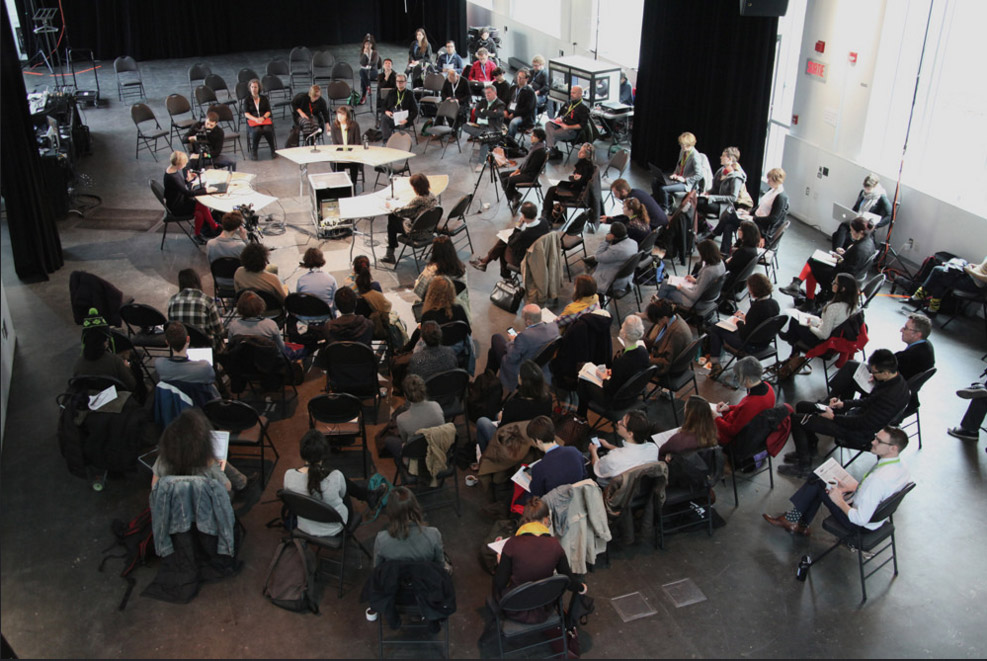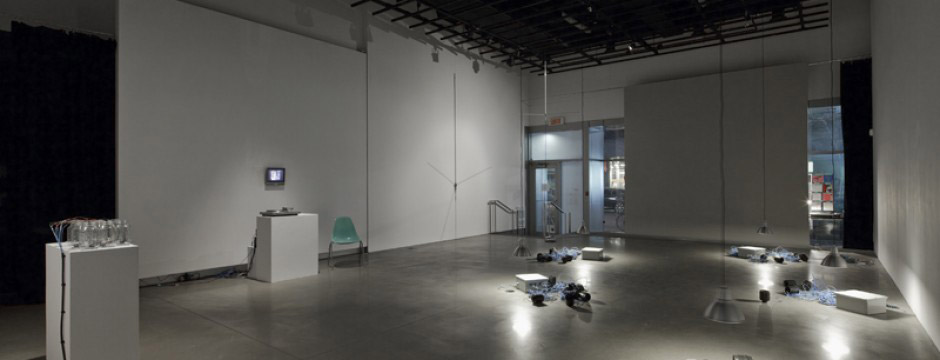
An Emerging Researchers’ Symposium addressed the theme Re-Create, considering research-creation as a methodology through media art and its history, its questions, processes and tools. The theme of research-creation also leads the exploration gallery where are surveyed multiple underlying, and recurring meanings of the Re prefix: a pre-formative or performative agent, impelling modification, transformation, derivation, flexion or contrast. Attached to a verb or a noun, those two letters define an action, an occupation, a place, a comparison, a frequency or diminutive; the person who puts forward an action, where the action happens, the research process or the process of creation.
Thus each panel of the ER Symposium is connected to an action and an actant: from the attempt at defining the scope of a practice to the confrontation of sense by the senses, from the acting powers of politics to the mobilization of transformative forces within the museum and academic institutions, the addressing of norms or limits. Each artist-researcher was invited to address research in relation to creation by aiming to do something, to create a movement: a need to define the re, to explain what it is and to understand the need of its use.
Media art is at the crossroad of multiple disciplines and methodologies: linkage strategies, tools, questions, processes. Media art is not a cluster but a link. ER aims at presenting various techniques and experiments or methods in research-creation surrounding the field of research and practice. A conscious overlap between panels aims at a crossover between questions non-fragmented, non-compartmented.
The Re-Create 2015, Emerging Researchers’ Symposium received proposals demonstrating the interest of many disciplines to the Media Art Histories (art history, education, media studies, communication studies, architecture, cultural studies, event design, philosophy, psychology, fine arts, editing, sound design, visual and critical studies, museology and conservation studies, archaeology, neural computation, science and technology, etc). It took place in a day with several speakers including Mirna Boyadjian, Peter Sachs Collopy and Lucile Haute contributing to this special issue of Archée. The Explorations Space had among others the work of Julien Éclancher and Taien Ng-Chan who share their thoughts on the concept of research-creation and their own creation method in this issue, while Whitefeather Hunter and Tristan Matheson present the Biomateria and Contagion Matters productions, exposed during the MAH event, and Pat Badani presents the interactive installation Make a move which occupied Agence Topo’s showcase.
The Explorations Space which accompanied the event, exposed as well the researcher-artists Lenka Novakova, Mikhel Proulx, Eden Unluata, Natalie Doonan, Tamara Vukov, Lindsey Lodhie, Ashley Scarlett, Thierry Guibert, Judith Dobler, Marie-Laure Cazin and Florencia Marchetti.

This 2015 Symposium * is the first edition of an emerging researchers’ independent event held during MAH. It was initiated by Chris Salter and Gisèle Trudel, co-directors of Hexagram, the network dedicated to research and creation in media arts, design, technology and digital culture.
This special issue of Archée demonstrates the creative and artistic aspect of production and research of emerging researchers gathered here exploring technologies and multiple fields of experimentation offered by media arts.
* The Emerging Researchers’ Symposium received invaluable financial, logistical and production support from Hexagram, as well as from the manager of the MAH Conference Manual Freire. The event also recognizes the support of Nina Czegledy KDMI Senior Fellow (U Toronto) who moderated the Bridge panel session and the Leonardo / International Society for the Arts, Sciences and Technology (ISAST) and the Relive: Media Art Histories editors (Leonardo Book Series, MIT Press) who delivered an award to the two best presentations of the Symposium. A blog led by the participants of the Symposium also allowed the extension of the debate beyond the five days.
